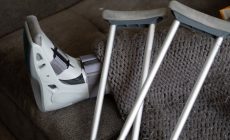It’s that time of the year again when cold weather is slowly setting in, and snow is right around the corner. Everyone’s preparing their homes for winter, but not many people think about their cars despite the safety implications!
Today we’ll show you a few tips on how you can prepare your car for winter. There’s an order of priority when it comes to winterizing your vehicle. First, we want to ensure that our cars will start and run in the winter. The other part of the equation ensures that our vehicle is safe to drive in harsh winter conditions.
Making Sure the Car Will Start and Drive Properly
Before we get into any details, we have to emphasize the importance of regular car maintenance.
Keeping your car well maintained and following proper fluid change intervals is key if you want to avoid expensive repairs. More importantly, if you want to avoid being stuck on the side of the road in a snow storm.
That being said, there’s a couple of things you should check before the first snowfall – the coolant/cooling system and the battery.
Checking the Coolant and Cooling System
Heat is a useful byproduct of all internal combustion engines. We use it to warm up the passenger cabin on cold winter mornings. However, it needs to be kept under control. The way all engines control internal temperature is with a complex cooling system and engine coolant.
Engine coolant comprised of distilled water and antifreeze. Your job is to check whether your coolant has enough antifreeze content to prevent it from freezing if temperatures go well below 32F. You can get a simple kit to test your coolant, or you can head over to your local mechanic, and they will check it for you.
At the same time, check if there’s enough coolant in the vehicle. Low coolant levels can lead to engine overheating, which is just as problematic in the winter as it is during the summer. Despite the rise of long-life antifreeze, you should change your coolant every two years.
Thermostat, Radiator, and Radiator Hoses
Once you’re satisfied with your coolant, it’s time to check the entire cooling system. Inspect radiator for leaks or damage. If your radiator has plastic parts, which is common these days, inspect them for cracks and hairline fractures. Do the same with both radiator hoses. Check to see if they’re stiff and brittle or soft and flexible. If they fit the former description, you might want to swap them out.
Lastly, turn the vehicle on and let it warm up to its optimal operating temperature. Listen for fan activating and watch that temperature gauge. It should stay in the middle of the scale at all times. Otherwise, you might have an issue with your thermostat or radiator fans.
Test the Battery
Every battery experiences a performance drop as soon as temperatures drop to near freezing. The same goes for car batteries. Just because your battery seems to be working fine at the moment doesn’t mean it will crank the engine during the bitter cold winter days.
Get your battery tested with a specialized tool that measures cranking amps. You can find these at your local auto stores or your local mechanic. Replace the battery if necessary.
Ensure that the Car is Safe to Drive
Now that we know our car will start and run, we need to check it’s actually safe to drive. We’ll go from the top down and check our windshield wipers, windshield fluid, brakes, and tires.
Are Your Windshield Wipers Underperforming?
Windshield wipers aren’t often used during the summer, but they are among the most important safety systems on your car during the winter. These two pieces of rubber (or silicone) will determine how far and how much you’ll see out of your car during a snowstorm.
Our friends over at eEuroparts.com have put together an awesome piece on why windshield wipers matter, which wipers work best, and why. You’ll find cool tips in their guide, while their blog is full of awesome car maintenance tips. We won’t go that far into detail, but we’ll say that you should invest in a good set of wipers, especially if your current ones have seen years of use.
As far as brands go, we generally recommend Valeo and Bosch, but there are many great brands out there that make decent wiper blades.
Windshield Fluid
As far as windshield fluid goes, there are two types – summer and winter fluid. The main difference between the two is that one could freeze if temperatures drop far enough, while the other is specifically designed to handle extreme cold. Having your spray nozzles freeze up is a safety concern.
Before you fill the windshield fluid tank with cold-weather fluid, do yourself a favor and remove the old fluid first. Leaving the old fluid in there can dilute the cold weather fluid, raising its freezing point. Changing the windshield fluid is one of those tips that can be a game-changer during the winter.
Inspect the Brakes
Let’s talk brakes. Maintaining your brakes should be done in intervals dictated by your car’s user manual or sooner, depending on your driving style. That being said, your brakes must be in good working order before winter kicks in.
There are three things you need to check – pads, rotors, braking fluid.
Worn out pads are a major safety risk, especially in the winter. Not only will you lose a lot of your vehicle’s braking ability, but you’ll also damage your rotors. Make sure there’s enough ‘meat’ on the pads at all times.
Rotors wear out over time. Unfortunately, they are also known to warp during cold winter days. All it takes is for you to brake hard for an extended period and then dunk the now smoking hot rotors in the cold snow. Such a thermal shock is often enough to deform the rotor and make it unsafe for driving. Keep an eye on your rotors if you value your safety.
Braking fluid should be changed every two years. It’s hygroscopic in nature, meaning that it attracts moisture and water. After two years of use, the fluid will be contaminated to a point where it no longer offers the necessary hydraulic properties. The contaminated braking fluid is another safety risk you should take seriously. It’s highly recommended that you use quality braking fluid at all times.
Inspect the Tires

Tires define how well your vehicle handles during snowy, winter days. There are two schools of thought. One that insists you should run winter tires from November to March, while the other feels that all-season tires will work as well. We lean more toward the former, and for a good reason. The on-road safety offered by winter tires is well worth the investment.
However, that isn’t to say that all-season tires won’t get the job done. They just won’t do it as well.
Choice of tires aside, it’s imperative that your tires have enough tread on them, no matter what kind they are. Driving on worn-out tires is extremely risky, especially during the winter. That’s just asking for trouble.
Aside from tread depth, you’ll also want to check the DOT on your tires. DOT number tells you how old your tires are. Anything older than 5-6 years is ready for replacement. Don’t cut corners with your tires. They are the only thing that’s keeping your vehicle on the road.
Preparedness Equals Safety
Safe winter driving is all about being prepared and cautious. If you pair the tips discussed above with regular maintenance, you’ll enjoy reliable and worry-free commuting during the winter. That being said, always drive following traffic conditions, and you’ll have no issues reaching your destination safely!























Leave a Reply
Your email address will not be published. Required fields are marked (required)